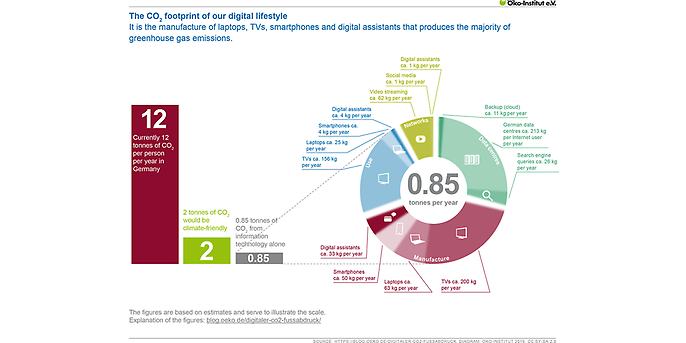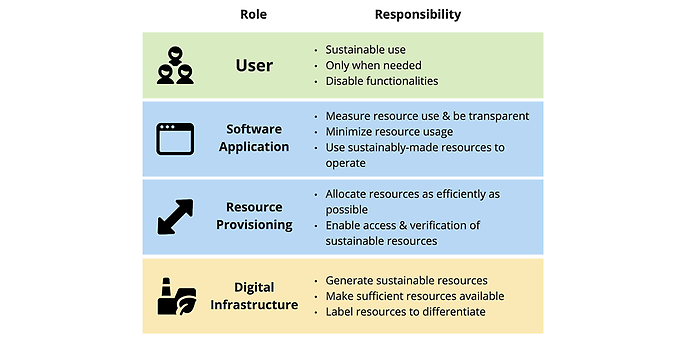28. December 2023 By Yelle Lieder
Green IT in our everyday lives – sustainable use of digital tools
The year is drawing to a close and many people use this as an opportunity to make New Year’s resolutions. I will exercise more, eat less meat or finally get around to cleaning up the passwords in my browser’s password manager – these are just a few examples of things we plan to do and want to do in the new year. Whatever you might think of the tradition, we should make our own resolutions if this helps raise awareness of important issues. In this blog post, I would therefore like to provide a bit of inspiration for New Year’s resolutions to make your digital life more sustainable.
The use of IT is one of the reasons we exceed our carbon budget
Your average person in Germany generates around 850 kg of greenhouse gas emissions through their use of digital solutions. The Öko-Institut has broken down the sources of our emissions in detail in Figure 1. 850 kg may not sound like a lot to some people, especially when you consider that in Germany we emit around 12 tonnes per capita per year. But if you consider that a climate-friendly carbon budget is only two tonnes per person each year, we are talking about just under 42 per cent of our budget that is used up by IT alone.

Figure 1: Öko-Institut | Personal digital footprint | Source: https://www.oeko.de/en/topics/digitalisation/
Sustainable use of digital tools
Needless to say, we should shut down our laptop in the evening and not just close the screen. And of course we should not buy the latest smartphone every two years. However, there are also many ways to take action that go beyond the recommendations that have been pounded into our heads for years.
Use e-mail sustainably
Every e-mail consumes resources and has a negative impact on the environment. The vast majority of e-mails sent worldwide are spam. As such, the first step towards more sustainable use of e-mail is to use a spam filter. Table 1 shows what a difference this can make. In addition, you should choose the group of recipients carefully, not send e-mails out to unnecessarily large mailing lists and reduce the number of superfluous thank-you and confirmation e-mails to a minimum. If you have to send an attachment, do not attach the file to the e-mail. Instead, make it available via a cloud storage service such as OneDrive or Dropbox and only send the link to the file in the e-mail. By doing this, the amount of data involved in transferring the file is limited by the number of recipients who actually click the link and want to access the document.
Sustainable browsing
For some time now, people like telling you that a Google search consumes as much energy as boiling a cup of tea. The fact that the environmental impact of new machine learning apps is increasing has also made it into the public conscious. More specifically, chat apps such as ChatGPT, which consume significantly more resources than simple Google searches, were recently the subject of discussion in terms of their impact on the environment. If you ask ChatGPT, it claims to use 1,567 per cent more energy to respond to a query than a Google search does. Now, you cannot blindly trust the chatbot and reliable data is hard to come by, but a new study by Hugging Face and Carnegie Mellon University shows that the figure is probably not far off, at least in terms of the overall dimensions involved. If you want to make searches more sustainable, it makes logical sense to use generative AI only for queries that cannot be answered by running a simple Google search.
In particular, interchangeable applications that essentially perform the same function – such as browsers – can easily be replaced by sustainable alternatives, of which there are many to choose from. Green Spector regularly compares different applications in the same categories, including browsers, video conferencing tools and dating apps. If you choose to use a sustainable browser, it also makes sense to use an ad blocker, since this reduces the amount of data that is exchanged with the end device. This is also true when it comes to website tracking, which often generates additional data – browsers such as Brave and Firefox already block many of the most common tracking tools by default.
Here is an effective little tip: tidy up your browser’s start page. By default, news pages with lots of media content are often the first thing you see when you open a new browser page. If you do not really use this function, you can save resources by setting a blank page as the default, for example.
The only thing missing now for sustainable browsing is a sustainable search engine. Ecosia scores quite well on average in Greenspector’s Ranking. Not only that, it also donates a large portion of its revenue to environmental protection, making the search engine sustainable on two levels.
Sustainable settings in digital tools
Enabling dark mode in apps can help to reduce the power consumed by the end device when in use. In addition, certain screen types require less energy to display saturated or dark colours since the pixels on the screen need to be brightened less. Since the screen accounts for a large portion of power used by many end devices, the decision to enable dark mode can quickly pay off from an environmental point of view. For devices equipped with an OLED display, this can extend the service life of mobile phone batteries by up to 9 per cent. That is a big energy saving when you consider the share of OLED displays on the market is rising all the time.
Watching videos in low resolution is generally not a good as viewing them in high resolution. However, if the video is not really what matters most, such as when you are listening to music on YouTube, it usually does not detract from the overall experience if you reduce the streaming quality of the video slightly. The same applies to your smartphone. Their small screens can only reproduce the high resolutions intended for PCs to a limited extent anyway, so it makes sense to lower the default settings for streaming quality on the device.
Following on from streaming, it is a good idea to download your favourite songs in your music app instead of streaming them over the Internet every time. Take Spotify as an example. This function is unfortunately only available with a Premium subscription, but if you have one, you can actively contribute to reducing the amount of data and hence energy used to transmit the songs over the mobile network.
Unfortunately, sustainability in most cases involves trade-offs. In recent years, we learnt that you do not have to make the trip to attend a meeting and that many things can be hashed out over a video conference call. This makes face-to-face interactions all the more important. To maintain interpersonal relationships and make social connections, it therefore makes complete sense that online meeting etiquette dictates that your camera be turned on during meetings. Just a quick note here: you can definitely overdo it and there are certainly enough opportunities in everyday life to leave the camera off and save some bandwidth.
Delete digital resources in the name of greater sustainability
The more data we store, the more physical storage media have to be made and ultimately disposed of. Each piece of information that we save also uses additional resources when we search for it or index it. Storing data and making it available also consumes energy all the time. This is premised on the fact that power use is roughly 0.89 Wh/TBh for HDDs and 1.52 Wh/TBhs for SSDs.
Erasing unneeded data therefore not only helps you to maintain a clear overview and work more effectively – it also helps to protect the environment. Regularly deleting e-mails from your recycle bin and files that are no longer needed from the download folder should therefore be something you do as a matter of course. Digital resources that you often forget about and tend to build up over time include chats and channels in communication solutions such as Teams or Slack, boards and projects in collaboration tools such as Miro, Trello or Asana as well as accounts with online services and cloud storage that you no longer use.
Responsibility for digital sustainability
The aim here is not to shift responsibility to the individual. Making it our collective responsibility whether or not we achieve climate targets is essentially a PR campaign of the oil and gas industry. As long as the business model of 100 companies is responsible for around 70 per cent of global greenhouse gas emissions, we have bigger fish to fry than unused apps on our smartphones. However, it would also not be right to assume that our actions on an individual level make no difference at all. The model for responsible action in digital sustainability (shown in Figure 2) from the Sustainable Digital Infrastructure Alliance provides a good starting point for any conversation on how much responsibility the individual user should bear.

Figure 2: SDIA | Responsibilities in the digital value chain | Source: https://miro.com/app/board/uXjVO220fQk=/
Strictly speaking, this should also be extended to include IT hardware, since this often has a greater impact from an environmental perspective. However, this would likely require a separate blog post due to the scope of the topic. I will therefore keep it short. Things that users need to consider in order to use IT hardware more sustainably include: taking into account repairability scores and eco-labels such as the Blue Angel when purchasing hardware; avoiding white keyboards and mice (since these turn yellow more quickly); using protective covers; and avoiding stickers and branding on laptops to make it easier to recycle them. And this is just the beginning. The list goes on and on.
I hope that these tips and tricks have given you some good ideas for your New Year’s resolutions. Good luck and have a happy New Year!
You will find more exciting topics from the world of adesso in our latest blog posts.
Also interesting:

